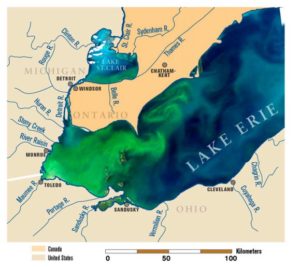 Water, Sustainability, and Climate – A collaborative research team, supported by the National Science Foundation, will evaluate the land-lake-air feed backs associated with climate and extreme weather events on Great Lakes communities, industries and the ecosystem. Key Question: What are the possible effects of climate-change-induced extreme events on water quality and ecology in the Great Lakes system, and what management strategies will be effective in addressing these changes?
Water, Sustainability, and Climate – A collaborative research team, supported by the National Science Foundation, will evaluate the land-lake-air feed backs associated with climate and extreme weather events on Great Lakes communities, industries and the ecosystem. Key Question: What are the possible effects of climate-change-induced extreme events on water quality and ecology in the Great Lakes system, and what management strategies will be effective in addressing these changes?
Project Goals:
- Enhance understanding of expected impacts of climate-change-induced extreme events on water quality and ecology, with the Great Lakes, using Lake Erie as a case study; and
- Develop a framework for integrating human and biogeochemical controls on water quality, ecology and climate that transcends and integrates across social, economic, ecological, hydrological and geosciences perspectives
Key Publications from our team:
Michalak, A.M., E. Anderson, D. Beletsky, S. Boland, N.S. Bosch, T.B. Bridgeman, J.D. Chaffin, K.H. Cho, R. Confesor, I. Daloglu, J. DePinto, M.A. Evans, G.L. Fahnenstiel, L. He, J.C. Ho, L. Jenkins, T. Johengen, K.C. Kuo, E. Laporte, X. Liu, M. McWilliams, M.R. Moore, D.J. Posselt, R.P. Richards, D. Scavia, A.L. Steiner, E. Verhamme, D.M. Wright, M.A. Zagorski 2013Record-setting algal bloom in Lake Erie caused by agricultural and meteorological trends consistent with expected future conditions. Nat. Acad. Sci. 110 (16) 6448-6452 Supporting Information
Obenour, D.R. A.D. Gronewold, C.A. Stow, and D. Scavia 2014Using a Bayesian hierarchical model with a gamma error distribution to improve Lake Erie cyanobacteria bloom forecasts. Water Resources Res.
Bertani, I, D.R. Obenour, C. E. Steger, C. A. Stow, A. D. Gronewold, D. Scavia 2016Probabilistically assessing the role of nutrient loading in harmful algal bloom formation in western Lake Erie. J Great Lakes. Res. in press
Scavia, D., J. D. Allan, K. K. Arend, S. Bartell, D. Beletsky, N. S. Bosch, S. B. Brandt, R. D. Briland, I. Daloğlu, J. V. DePinto, D. M. Dolan, M. A. Evans, T. M. Farmer, D. Goto, H. Han, T. O. Höök, R. Knight, S. A. Ludsin, D. Mason, A. M. Michalak, R. P. Richards, J. J. Roberts, D. K. Rucinski, E. Rutherford, D. J. Schwab, T. Sesterhenn, H. Zhang, Y. Zhou (2014). Assessing and addressing the re-eutrophication of Lake Erie: Central Basin Hypoxia
Journal of Great Lakes Research. 40 (2), 226.
Bosch, N. S., M. A. Evans, D. Scavia, J. D. Allan (2014). Interacting effects of climate change and agricultural BMPs on nutrient runoff entering Lake Erie Journal of Great Lakes Research. 40 (3), 581
Richards, R.P., I. Alameddine, J.D. Allan, D.B. Baker, N.S. Bosch, R. Confesor, J.V. DePinto, D.M. Dolan, J.M. Reutter, and D.Scavia (2012). Discussion – Nutrient Inputs to the Laurentian Great Lakes by Source and Watershed Estimated Using SPARROW Watershed Models. DOI: 10.1111 ⁄ jawr.12006
Kalcic, M., Kirchhoff, C., Bosch, N., Muenich, R., Murray, M., Gardner, J., Scavia, D. (2016). Engaging Stakeholders to Define Feasible and Desirable Agricultural Conservation in Western Lake Erie Watersheds
Environmental Science and Technology.
Muenich R.L., M.M. Kalcic, D. Scavia (2016). Evaluating the Impact of Legacy P and Agricultural Conservation Practices on Nutrient Loads from the Maumee River Watershed Environmental Science & Technology.